MI Library
Scholarly research is a key enterprise at the Medieval Institute and the Medieval Institute Library holds a collection of unequaled resources essential to the study of the Middle Ages.
As early as the 1930s, Notre Dame’s library began acquiring resources to support the study of the Middle Ages. The collection was bolstered by the establishment of the Medieval Institute in 1946, a period of postwar growth, and nearly nine decades of dedicated collection building. Today, the Medieval Institute Library houses some 30,000 books across six reference collections in five designated reading rooms. It also holds over 60,000 circulating volumes in the Medieval Institute General Collection and over 12,000 reels of microfilm from the Ambrosiana Library.
Faculty and students alike note that the rich collections, all in close proximity to each other, allow for a unique and immersive research experience. They are the backbone of daily work for the Notre Dame community and have made Notre Dame a research destination for medievalists, byzantinists, and other scholars from around the world.
— Julia Schneider, Ph.D., Medieval Studies Librarian
Librarians
Medieval Studies Librarian
Dr. Julia Schneider
Byzantine Studies and Classics Librarian
Dr. David T. Gura
Using the Reading Rooms
All readers are expected to follow the Code of Conduct.
Hours
The Medieval Institute Reading Rooms on the seventh floor of the Hesburgh Library are open to the general public, including all Notre Dame faculty, staff, and students, every week day from 8 a.m. to 5 p.m. After-hours access may be granted with the permission of the Director of the MI in consultation with the Medieval Studies Librarian.
More Information
Hesburgh Libraries' Medieval Institute Library page
Medieval Studies Research Guide
Byzantine Studies Research Guide
Our Reading Rooms
Collections and Appointed Reading Rooms
The Medieval Institute's Reading Rooms house a wealth of primary and reference materials, each devoted to particular subject areas along geographical and chronological lines.
Located on the 7th Floor of Hesburgh Library, the Reading Rooms and their collections are open to all patrons from 8 a.m. to 5 p.m., Monday through Friday, except on University holidays. The Medieval Institute General Collection in the open stacks is available whenever the library building is open.
The General Collection and Reference Collection
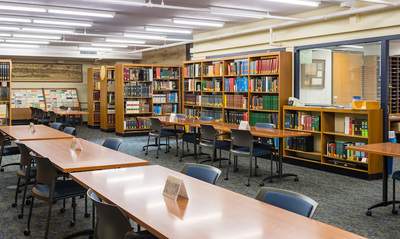
Professor Francis D. Lazenby, the first Medieval Institute Librarian at Notre Dame, created the original General and Reference Collections in 1956.
The General Collection, located in the open stacks on the 7th Floor, features a wide range of valuable publications and rare materials for studying the Middle Ages. Holdings cover all medieval subjects, with particular strengths in philosophy, theology, manuscript studies, and religious history. This collection includes works from the personal library of Jocelyn Hilgarth—some of these materials are rarely found outside of Spain. It also features many works, some hard-to-find, on the medieval religious orders, with especial strengths in the histories of the Carthusian and Cistercian orders. As you browse, you will find some volumes inscribed by the authors themselves, showing the connection between scholars across geographical and disciplinary distances, given as a token of mutual respect.
The Medieval Institute Reference Collection is located inside the Main Reading Room and contains a wide range of primary and reference works in many languages with emphasis on theological and philosophical works and their authors. The Main Reading Room is a centralized space with access to the many lexica, ecclesiastical and social histories, and other extensive series of texts. This design fosters a streamlined and immersive research experience. Scholars have access to the materials they need all in one place and in a well-appointed work environment.
Paleography Collection (Room 715Q)
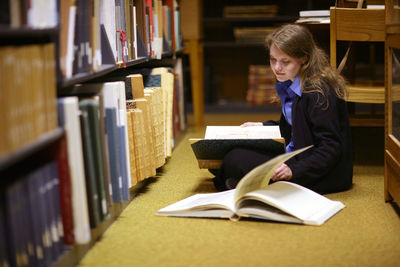
The Paleography Room is an essential resource for scholars of manuscript and book history. It houses an extensive collection of manuscript catalogs and scholarship on manuscript and early print culture. Its contents address every aspect of medieval and early printed book production, from codicology and paleography to library history.
The collection of manuscript catalogs from around the world provides a comprehensive research experience—scholars can work with manuscript descriptions from multiple libraries at one time and in a single location.
A facsimile of the Book of Kells remains on permanent display in this room. It can be found along with other facsimiles in the Medieval Microfilms and Facsimiles Database.
Astrik L. Gabriel History of Universities Collection (Room 715E)
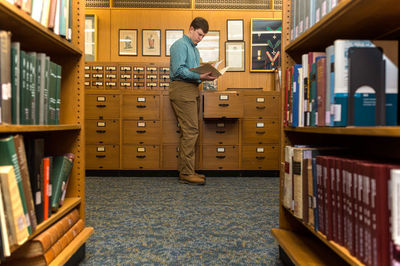
The Universities Room is a unique research center with a diverse and sweeping collection of rare materials. It was established by Canon Gabriel and saw remarkable growth during his tenure as the director of the Medieval Institute due to strategic acquisitions and the generosity of benefactors.
The collection covers the history of education, primarily focusing on European universities in the Middle Ages and early modern periods. In addition to a vast array of print materials, the collection includes an extensive set of Gabriel’s research notes and his prosopographical file on students at Hungarian and other European universities.
The Gabriel Collection includes nearly two thousand microfilms of medieval manuscripts, available for use upon request. The most valuable items are two films of Stephen Langton’s Quaestiones (Chartres, Bibliothèque Municipale MS 430)—the only known films of this manuscript, which was destroyed during World War II.
Ambrosiana Research Collection (Room 715F)
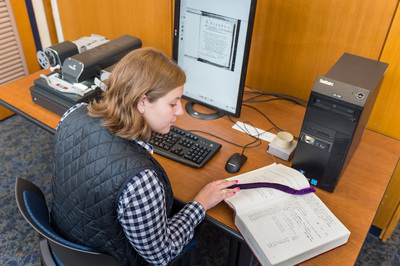
The world-class Ambrosiana Collection was born from the vision of long-time friends Giovanni Cardinal Battista Montini of Milan (later Pope Paul VI) and Reverend Theodore M. Hesburgh. This friendship became the cornerstone of the enduring relationship between the Medieval Institute and the Biblioteca Ambrosiana in Milan, Italy, which began more than fifty years ago.
The seeds for the Ambrosiana Collection were planted when Cardinal Montini made a historic visit to Notre Dame in 1960. Cardinal Montini and Fr. Hesburgh discussed at length how two world wars had destroyed books and manuscripts resulting in the loss of shared intellectual heritage. Considering the possibility of ultimate destruction brought on by nuclear war, they took steps to preserve the content of the Amrosiana’s manuscript collection using microfilm. An extensive fundraising campaign began and the project was underway.
To support the use of these microfilms and the study of the Biblioteca Ambrosiana, there is a small print collection focused on the contents of the library, its history, and the history of northern Italy during the medieval and Renaissance periods.
Today, the Ambrosiana Collection at Notre Dame includes more than 12,000 reels of microfilm images of the Ambrosiana’s Latin, Greek, Arabic, Hebrew, European vernacular, and semitic language manuscript holdings, available for study upon request.
Two related projects emerged between Notre Dame and the Ambrosiana. In 1984, Louis Jordan (Associate University Librarian) and Susan E. Wool published a partial print catalog for western manuscript holdings in the Ambrosiana. Soon after, Robert Randolph Coleman (Emeritus Professor of Art History) headed the cataloging of the Ambrosiana’s extensive collection of drawings, including the works of artists like Leonardo da Vinci, Raphael, and Albrecht Dürer.
The spirit of collaboration continues between the two institutions to this day. Coleman continues working with the Ambrosiana to digitize drawings and make them visible via the Ambrosiana website using a software platform designed and managed by the Hesburgh Libraries. In addition, Notre Dame and the Hesburgh Libraries are guiding the Ambrosiana and its Library Director, don Federico Gallo, as they create a digital collection of their manuscript and early printed book holdings.
Byzantine and Classics Reference Collection (Room 714)
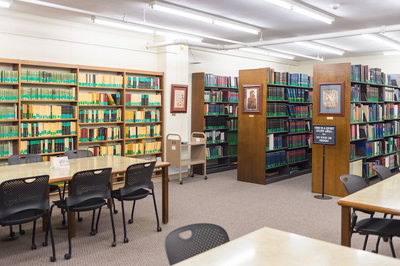
In the 1990s, Notre Dame acquired the expansive personal library of Milton V. Anastos, professor of Byzantine Greek at UCLA. This collection, focused on Byzantine and classical civilization, started the Medieval Institute on the path to become an international research center in Byzantine Studies.
Housed in the Stavros Niarchos Reading Room, the Byzantine and Classics Reference Collection is focused on the primary sources of classical antiquity and Byzantium, which, according to Anastos, are "the traditions of ancient Greece, the legal and political institutions of pagan Rome, and Christianity."
Byzantine art, law, and theology represent the major achievements of the culture that undergird these holdings. In Anastos’ view, the Byzantine and ancient worlds could not be understood separately—his acquisitions over decades reflect this deeply held belief.
These reference collections are vital resources for Notre Dame’s world-class Byzantine Studies and Classics programs as well as for visiting scholars from around the world. In addition, because Anastos’ personal library was so massive, non-reference materials can be found in the Medieval General Collection and Hesburgh General Collection.
Near Eastern Reading Room and Reference Collection (Room 714B)
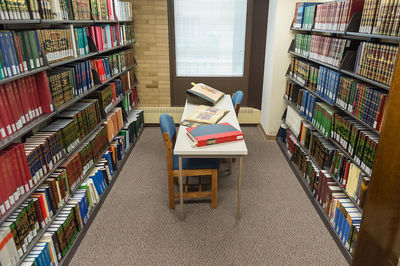
The Near Eastern Reading Room and Reference Collection can be accessed through the Stavros Niarchos Reading Room. The space was originally designated for this use by Professor Olivia Remie Constable (beatae memoriae), Director of the Medieval Institute from 2009-2014, and well-known historian specializing in interactions among cultures in the medieval Mediterranean.
The Near Eastern Reference Collection was purchased through a grant awarded to Professor Gabriel S. Reynolds and sponsored by the Hesburgh Libraries and Notre Dame Research. It supports research on cultural interchange in the Mediterranean and Near East from antiquity through the Middle Ages, with an emphasis on the interaction between Christianity and Islam. The wide array of materials focus on theology, history, and geography and include related reference resources.